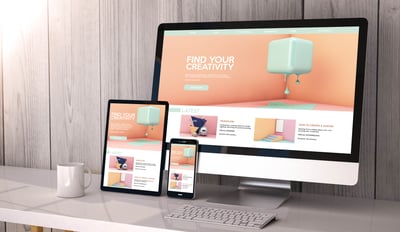
You’ve set up a website for your new business, and it’s getting plenty of traffic.
There’s just one problem: it’s not making any money.
When that’s the case, it’s time to take a long hard look at the quality of your web design. The layout and design of your website has a huge impact on the amount of money you can make.
It affects everything from bounce rate to conversions to links back to your site – all of which contribute in some way to your bottom line.
This article will cover nine important web design tips you can start working on right now to help your website earn more money.
Virtually every website can make some improvements to its user experience – and by extension, revenue generation.
Maximizing revenue on your website is an ongoing process. There’s always something else you can do to make visitors happier and boost the bottom line.
The nine tips we’ve outlined below are an excellent place to start, but here are a few other ways you can get inspiration for improving your website.
If you need a boost to your site now rather than later, keep reading to learn our top web design tips that will help your site make more money.
It’s happened to all of us: you click on a link and wait for it to load…and keep waiting…and waiting…until you give up and go find a different site that loads more quickly.
Nothing causes a visitor to bounce faster than a slow-loading website. In fact, 47% of users bounce after viewing just one page on a site.
That means site speed is a crucial part of improving your web design.
You can use a free tool like Google’s Page Speed Insights to find improvements. When you enter your URL into the tool, it will generate a list of suggestions that looks like this:
Usually, the suggestions will center on optimizing your images and reducing unnecessary JavaScript or CSS code.
If you’re not a professional web designer or developer, this list might seem like a lot of jargon. You can hire a web developer for help in addressing these problems.
Improving site speed is a constant process. There will always be something you can do to make your site run faster. Try setting aside time each week or month to run site speed checks and make continual improvements.
Your homepage headline is the first thing that grabs your readers’ attention. It should pull them in right away and let them know they’re in the right place.
To do this, your headline content should include two parts: SEO keywords and strong descriptive language.
Keywords are your way of letting the reader know your site is relevant to whatever they’ve just typed into Google. They also help search engines understand and rank your website. Descriptive language tells your visitors why they should stay on your site rather than visit a competitor. Usually, the descriptive language highlights your company’s unique selling point.
Take a look at this example for a plugin for the WordPress website builder.
“WordPress page builder” is the keyword. It’s very likely that users searched for this phrase or some variation. Seeing those words in the headline helps visitors know they’ve found what they’re looking for.
Then, “design superpowers” provides an engaging description of what the visitor will find if they use this product. It’s catchy and exciting, leaving users wanting more.
It’s important that the descriptive language in your headline and other website content reflects your brand. Address the specific needs and pain points of your target audience at every opportunity.
For instance, you might consider emphasizing your low prices compared to competitors or providing social proof to demonstrate that you are a trusted player in this niche.
Think about some of the most effective website designs you’ve seen.
How did the web designers emphasize the most important content? How did you, as the visitor, understand how all the pieces are related to each other?
There’s one simple principle: visual hierarchy.
With visual hierarchy, web designers use size, color, proximity, and other principles to demonstrate the importance of certain website elements or content.
Check out this blog post about how to write a case study:
Visual hierarchy encompasses a complex set of concepts that professional web designers heavily rely on. If you’re using a website builder or designing a website through other means, you can use some of these tips to incorporate visual hierarchy into your web design.
With more than a billion websites out there, you might be tempted to create something totally unique so you can stand out.
Don’t do it.
Most internet users have come to expect certain types of layouts on most websites. Asymmetrical elements, mismatched fonts, or other unusual visual elements can cause confusion. It’s in your best interest to give users a layout they expect. Then, you can use content to show them what makes you a better choice than your competitors.
Take a look at this example from a document signing software solution.
Although this is just a portion of the homepage, you can see how this website uses clearly defined sections to convey important information to visitors.
The website provides information in order of importance. As you move through the page, the site gradually builds its case for its product. Also, notice how the site uses a consistent color palette and catchy subheadings to keep you engaged?
The layout for this website is predictable – and that’s a good thing. The company makes a case for its product through website content, which is far more effective.
Sixty-four percent of all web traffic now takes place on a mobile device, and that percentage is only growing each year. Plus, Google now indexes and ranks websites based on the mobile version of the site.
In short, you should consider the mobile version of your website as the primary version.
To understand how your site is currently performing on mobile, use Google’s mobile-friendly test tool to generate improvement suggestions.Like the Page Speed Insights tool discussed above, the mobile-friendly test will identify specific issues that you can fix to improve performance.
In general, you can use these web design tips to optimize your website for mobile users:
Organizing content behind tabs or accordion boxes can make your site feel neat and clean. Plus, Google recently confirmed that hidden content like this will still be read and indexed by the search engine.
Despite these advantages, hidden content carries a huge risk: what if your visitors don’t see it?
The key to web design that makes you money is making it as easy as possible for your visitors to see and understand your content. Every time they have to click, you’ll lose a few potential customers.
If you have a lot of content that’s proving difficult to organize and navigate efficiently, consider adding side navigation like in this article about project management software.
The side navigation provides a clear overview of everything users can find on the page. Instead of hiding content behind these subheadings, each heading works as a jump link to bring the user directly to that section of the page.
Considering the article is over 5,000 words long, this setup saves users a lot of scrolling. And saving time for users often means a better chance of generating more revenue from them.
We’ve all seen websites with stock photos that are low-quality, irrelevant, or just plain weird.
When you rely too heavily on bad stock photos, users may not take your site as seriously. You may seem unprofessional or simply not as experienced as your competitors.
To avoid these associations, use custom photos or imagery whenever possible. Adding that personal and unique touch can make a big difference. See how Frevvo incorporates custom photos on their process automation article:
While custom illustrations and professional photos can be pricey, they’re often worth the investment. If a large-scale project like that is outside of your budget, consider hiring a freelance photographer to take product or staff photos to include on your website.
Sometimes, stock photos may be your only option. If you have to use stock photos, follow these tips for picking high-quality ones:
As you write content for your website, it’s easy to fall into industry jargon. After all, you know the ins and outs of your product or service better than anybody.
On the other hand, your website visitors won’t have any idea what you’re talking about.
To create the most effective website design, you need to translate your expertise into simple language that your target audience can understand. To do that, you’ll first need to develop a deep understanding of that audience. Then, you can tailor your content to their preferences.
Here’s a quick example. A jargon-heavy version of this article’s headline might be something like this:
Instead, we’ve opted for:
Both of these headlines have the same meaning, but the second is more approachable and understandable for your average user.
If you want to make money from your website, you need to ask your users for it. In web design, this usually comes in the form of a call-to-action (CTA) button.
CTA buttons are typically in a contrasting color and use strong action words. Here are a few examples of good, action-oriented CTAs:
Many new web designers make the mistake of sticking one CTA button at the top or bottom of each page. With this approach, you miss out on a lot of opportunities to capture leads and generate more revenue.
When a CTA is only at the top of your page, visitors haven’t yet had a chance to decide if they want to make a purchase. They’ll likely scroll past it to learn more, but if they can’t find another CTA, they may leave without making a purchase.
Sticking one CTA at the bottom presents the opposite problem. If visitors don’t scroll all the way to the bottom, they won’t see how they can take action.
Instead, it’s smart to incorporate CTA buttons at regular intervals throughout your page. You don’t want to overwhelm visitors, but between two and five CTA buttons will provide visitors with a proper chance to convert.
Take a look at this CTA example from an article on finding the best PEO companies. In a 3,000 word article, there are three of these CTAs located at strategic points.
These CTA buttons provide readers with plenty of opportunities to take action. Because of the bright orange button color, they stand out as the reader scrolls through the page. Taken together, these CTA elements generate a higher chance for users to convert while scrolling through this article.
These CTA buttons provide readers with plenty of opportunities to take action. Because of the bright orange button color, they stand out as the reader scrolls through the page. Taken together, these CTA elements generate a higher chance for users to convert while scrolling through this article.
There’s always something you can do to give your website visitors a better experience. At the end of the day, this will help you earn more money from your online presence.
Whether you’re an affiliate blogger, an up-and-coming SaaS provider, or an established e-commerce powerhouse, it’s worth taking a look at how you can improve the user experience on your website.
With these web design tips, you’ll be off to a great start with providing a better website experience and boosting your bottom line.
If you’re ready to build (or upgrade) a website that doesn’t just look good but also drives results, you’ll need the right tools. Check out the best web design solutions to create a high-converting site today.
Vikas Kalwani is a product-led growth hacker and B2B Marketing Specialist skilled in SEO, content marketing, and social media marketing.
It takes about five seconds for users to form an opinion about a website and decide whether...
 by Vinod Janapala
by Vinod Janapala
In 2019, on average, 99 percent of consumers check their personal emails at least once every...
 by Victoria Taylor
by Victoria Taylor
Creating a website that converts is like following a carefully-crafted recipe—even one missing...
 by Elyssa Helfman
by Elyssa Helfman
It takes about five seconds for users to form an opinion about a website and decide whether...
 by Vinod Janapala
by Vinod Janapala
In 2019, on average, 99 percent of consumers check their personal emails at least once every...
 by Victoria Taylor
by Victoria Taylor


